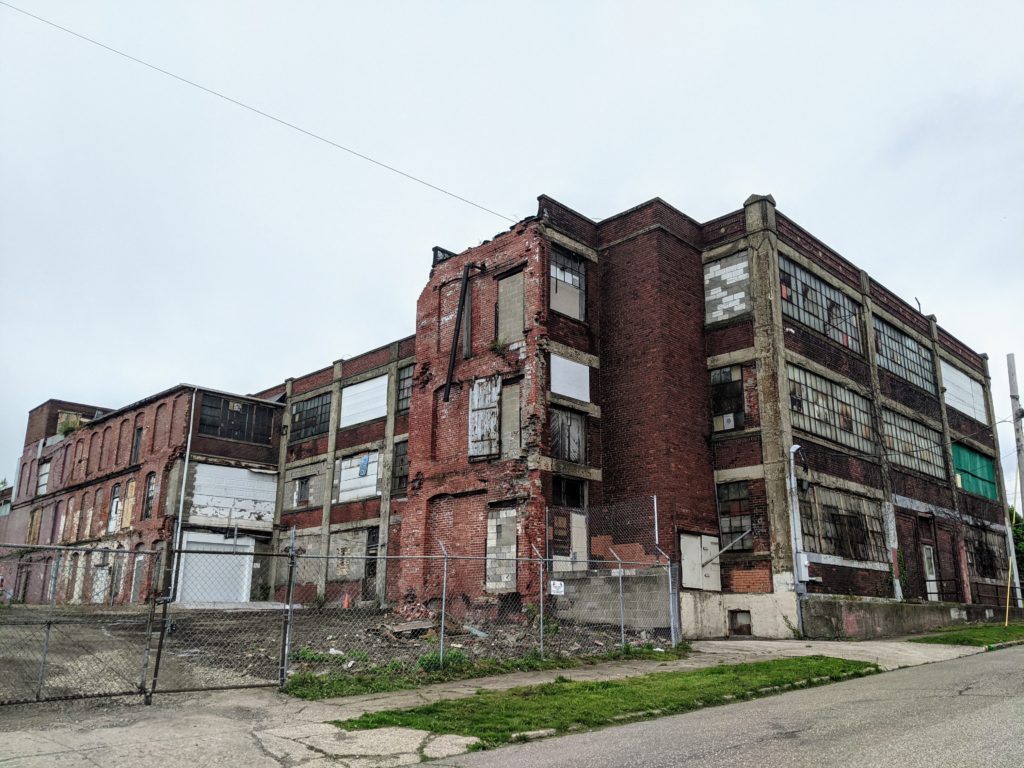W. 20th and Liberty Streets, Erie, PA
The history of the building at 20th and Liberty goes back to the late 1800s when the site was a manufacturing plant for The Black Manufacturing Company, which produced bicycles. In 1903, the building became Continental Rubber Works, which was founded by Theron Palmer with the assistance of Alex and Charles Jarecki, who were prominent Erie manufacturers. The Rubber Works added new machinery to the factory in order to produce it’s rubber products, much of which was still associated with bicycle manufacturing, including bicycle tires and tubes, as well as other molded products and hoses. The building made up approximately 11,000 square feet of manufacturing space and was expanded to take up the entire block from Liberty to Plum in 1914.
Erie Forge and Steel purchased the plant in the 1960s and operations of the building as a plant ceased shortly thereafter. In the 1980s and 1990s, a concert venue called the Continental Ballroom was run from a space in the building on the corner of 20th and Plum, but code and safety violations shut that operation down in the late 1990s. The building was vacant and in severe disrepair for many years thereafter. There are tenants in portions of the building now, but other areas of the building are seriously dilapidated, with crumbling bricks, broken out windows and structural damage. This is a large, recognizable piece of Erie’s manufacturing, labor, and architectural history that could be adaptively reused in a variety of creative ways.
The property was purchased in March of 2021 by Leon Commercial Leasing, LLC, who has appealed to the zoning board for permission to construct a new warehouse with a dimensional variance. There is concern that this building is in immediate danger of demolition or major departure from its current footprint with potential loss of the architectural elements that make it recognizable as a part of Erie’s manufacturing history.
UPDATE (September 2021):
In June 2021, Preservation Erie published the current list of Erie County’s Most Endangered Properties. These properties were either identified by the Endangered Properties List Committee or via submissions from the public. After researching ownership histories, assessing current conditions, and determining the levels and types of threats for nominated properties, Preservation Erie named nine properties that were found to be in danger of being lost to the community by wrecking ball, slow neglect, or disuse. The purpose of this list is to bring awareness to the community of these vulnerable historic resources.
Among those nine properties was the Continental Rubber Works building on W. 20th and Liberty Streets. According to public record, the owner of the property applied for a demolition permit and zoning variance through the City for the property. However, shortly after the list was published, Preservation Erie was contacted by the owner of the property, Leon Construction, to clarify that the demolition permit was issued for an outbuilding, which is not connected to the actual structure of the Continental Rubberworks building.
Two members of the Endangered Properties List Committee met with a partner at Leon Construction and were shown plans from the architect that the company is working with to rehabilitate and repair the Continental Rubber Works building. Implementation of the plans for the 170,000 square foot space will begin towards the end of this year. As the project progresses, the company will focus on structural issues, as well as window and elevator repair work. The ultimate goal for the building is twofold: one, to house a commercial storefront (realizing the owner’s dream of owning a bakery) and two, to convert the remainder of the warehouse space into climate-controlled self-storage.
This project is going to take years to complete, as well as a large financial commitment, but in speaking with Leon Construction, we found them to be excited to invest in this building for the benefit of the neighborhood. The company wants to be a part of making Erie a better community. The future of this structure, which reflects Erie’s industrial roots, looks positive.


